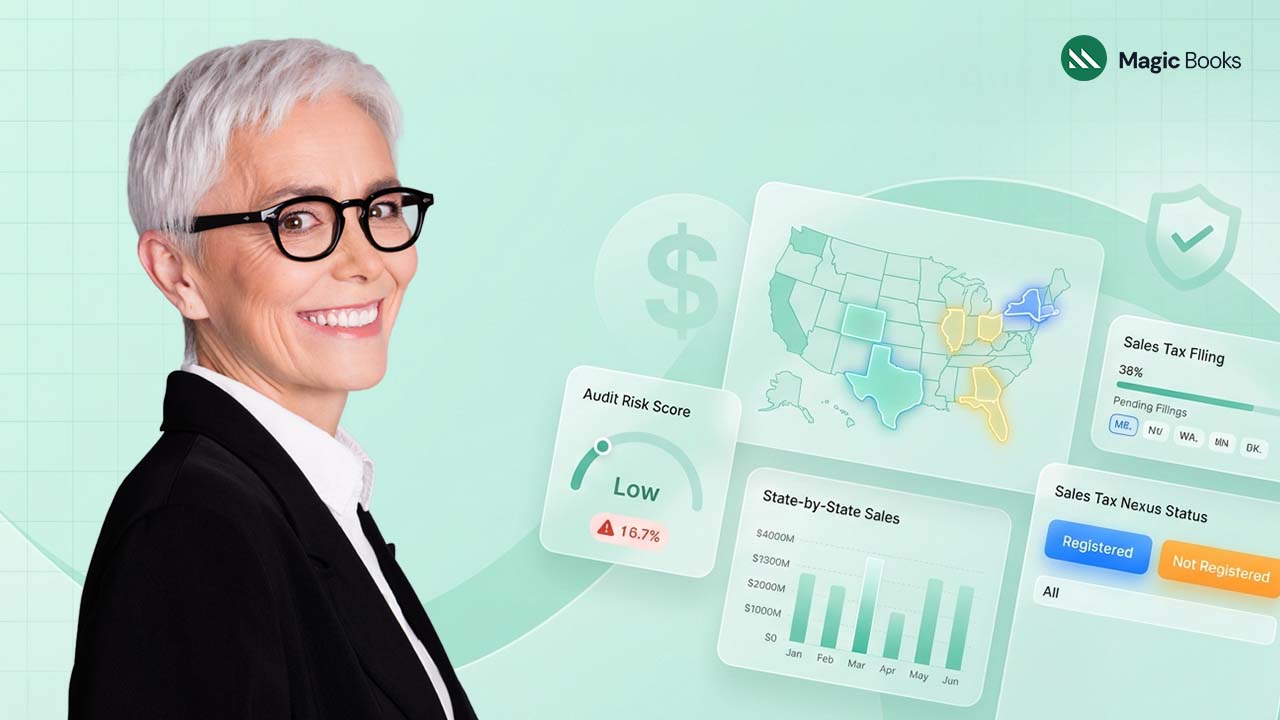Growing a business into new B2B and B2C markets can be venturing into virgin territory. Take, for example, a mid-sized maker of green office furniture, about to open its first distribution center on the West Coast: the boardroom is abuzz with excitement, projections shine on the PowerPoint charts, and the CEO is already thinking of doubling sales in a year. But with a poor navigation compass of financial metrics, even the most ambitious growth plans can fail because of hidden costs, cash-flow stress, or over-leveraged balance sheets. This guide is designed to demystify six key financial metrics that will be your navigation tools, making growth both sustainable and profitable.
Our purpose is clear: for financial advisors, bookkeepers, and accountants advising clients through growth spurts, these metrics are non‑negotiable checkpoints. We’ll illustrate each metric with real‑world examples—from a SaaS startup that mis‑timed its marketing spend and teetered on insolvency to a retailer that renegotiated its debt covenants under pressure. Along the way, we’ll also touch on key elements of the U.S. regulatory context, such as GAAP compliance and SEC filings for public firms, to remind you of the guardrails that frame every financial report.
At the completion of this guide, you will have a complete playbook: calculations for each metric, industry standards, real-world guidance on how to wed finance and ops, and a roadmap for putting these metrics into action in automated dashboards. Let us begin this journey with a trusty compass in hand.
1. Revenue Growth Rate—Measurement of Top-Line Momentum
Revenue growth rate, year-over-year percentage sales growth, is generally the earliest warning sign if a growth deceleration is felt. In its simplest form, the equation is a comparison of this year’s revenue over a time frame against the same time frame’s last year’s revenue:
For example, a leading furnishing firm that invested significantly in a new digital campaign during the first quarter saw 20 percent advertising expense growth. Yet, revenue in the same quarter grew merely 8 percent year-over-year, and the management was looking for an explanation of further growth in advertising spend budget. A good growth would lead to a top-line growth at least equivalent to the incremental investment; therefore, if marketing expense is increased by 20 percent, one would expect revenue growth of more than 15 percent to have a positive return on advertisement expense.
Monitoring revenue growth rate on a monthly and quarterly level allows finance teams to spot underperforming initiatives early, before cash is wasted. It also feeds into cash-flow planning: a persistent deceleration in growth requires tighter working-capital management, while a spike might require faster CapEx budgeting to meet production capacity. Bottom line: revenue growth rate is your canary in the coal mine: watch it zealously to make certain that each dollar spent on expansion is returning commensurate value.
2. Gross Profit Margin—Ensuring Robust Unit Economics
Gross profit margin calculates the proportion of each dollar of revenue left after paying the cost of goods sold (COGS). Stated as:
This metric is the guardian of unit economics. When new SKUs are launched by a company or it sells in different channels, COGS can swing wildly—raw-material prices can jump, freight can increase, and supplier discounts can vanish once volumes creep beyond negotiated levels.
Suppose a manufacturing customer watched its gross margin shrink from 38 percent to 31 percent over the six months it took to move to Latin America, mainly because of increased import tariffs and unexpected logistics charges. If the finance organization had simulated gross-margin results under different assumptions about costs, it might have negotiated shipping contracts or price levels in advance. Instead, the margin squeeze resulted in a hasty price increase that unsettled the sales force and scared away new business.
By monitoring gross margin by product line and customer segment, you can observe early margin pressure. Incorporate COGS variance analysis into monthly close processes and stress-test your gross-margin assumptions across alternative cost scenarios. Providing leadership with this information ensures pricing strategy and growth plans stay in sync with solid unit economics.
3. Operating Cash Flow—Maintaining Liquidity During the Growth Stages
Paper profitability is not necessarily bank liquidity. Operating cash flow, reconciling net income to non-cash expenses and working-capital changes, reveals the actual cash a firm generates from its core business. Expansion typically comes with up-front costs—inventory building, customer-acquisition expenses, and signing bonuses—that can double the profit-to-cash gap.
Let’s take, for instance, A SaaS company. Following Series B funding, DataDrive almost doubled its salesforce within three months. While revenue increased 40 percent year-over-year, the operating cash flow of the company turned negative by $2 million through postponed customer payables and high payroll costs. DataDrive teetered on the edge of a cash deficit without the use of cash-flow planning, compelling its CFO to seek an expensive short-term credit facility.
Best practices are to keep rolling 12‑month cash‑flow projections up to date monthly and directly linked to marketing and CapEx budgets. Having cash‑flow projections as part of your advisory arsenal enables you to sell flexible financing solutions—such as revolvers or supply‑chain financing—before liquidity problems become solvency problems. Keep in mind, in an expansion, cash flow does.
4. Customer Acquisition Cost to Lifetime Value (CAC/LTV) ratio
No metric so well captures growth efficiency as the LTV: CAC ratio. Customer Acquisition Cost (CAC) is calculated by taking the total marketing and sales investment and dividing it by the number of new customers acquired within a time period, and Lifetime Value (LTV) projects the net income a customer will generate during their lifetime with the company. A healthy ratio—typically mentioned as at least 3:1 for B2B SaaS and slightly more than 2:1 for B2C e-commerce—is an indicator that the company is building long-term value that includes the cost of acquisition.
In a single rapid growth spurt, an online health-products seller increased CAC 35 percent using a mix of display ads and influencer marketing. But careless upsell programs only lifted LTV 10 percent, dropping the LTV: CAC ratio below 1.8:1 and compromising growth profitability. By collaborating with marketing to take advantage of high-margin touchpoints—email nurturing, targeted referrals, and subscription tier bundles—the finance team then lifted LTV 25 percent and lowered CAC 12 percent, restoring the ratio to a robust 2.7:1.
To keep these in equilibrium, create dashboards monitoring CAC and LTV jointly, channel, and segment‑sensitively. Facilitate finance‑marketing collaborations: marketing can conduct A/B tests to minimize CAC, while finance can forecast customer‑value programs—upsells, cross‑sells, retention promotions—to increase LTV strategically.
5. Debt‑to‑Equity & Interest Coverage—Balancing Leverage
Leverage is a two‑edged sword. In moderation, debt can enhance returns; in abundance, it can burden a company with excessive interest costs and onerous covenants. Two ratios are deserving of close scrutiny: Debt‑to‑Equity (total debt to shareholders’ equity) and Interest Coverage (EBIT to interest expense). Mid‑market firms like to maintain a debt‑to‑equity ratio of 0.5 to 1.5, with interest‑coverage ratios above 4x for easy covenant compliance.
A regional retailer financed an accelerated brick-and-mortar growth in the form of a leveraged credit facility, and its debt-to-equity level reached a level higher than 2.0. As the increase in sales failed to deliver, the interest coverage ratio fell below 3x, triggering bank covenances that banned further borrowing and forced the Chief Financial Officer to renegotiate high borrowing levels (Moody’s 2024). This delay hinderedthe opening of new stores and strained relations with landlords.
Advisers are encouraged to go through prospective debt structures in terms of conservative revenue projections, thus stress-testing interest cover at diminishing EBIT levels. Through proactive covenant flexibility negotiations and the incorporation of uncommitted working-capital lines, financing teams can achieve the right balance, utilizing growth without jeopardizing financial distress.
6. Return on Invested Capital (ROIC)—Measuring Expansion ROI
Return on Invested Capital (ROIC) quantifies the effectiveness of incremental capital to generate returns. Defined as:
It compares performance to the firm’s weighted average cost of capital (WACC). When ROIC is lower than WACC, the growth is destroying shareholder wealth.
In another instance, a technology company invested heavily in new server hardware and data-center alliances, only to watch ROIC decline from 12 percent to 6 percent, below its WACC of 8 percent. The board put the expansion on hold until capital effectiveness was reevaluated based on a Bain & Company study, which suggested substituting cloud alliances and a phased rollout that returned ROIC to 10 percent in nine months.
Ask finance leaders to include ROIC in board-level reports and systems of capital allocation. Comparing every additional dollar of investment to the WACC benchmark, firms can be confident that every dollar invested in expansion creates, rather than destroys, value.
Practical Lessons and Follow-Up Actions:
Embarking on an expansion journey with the six critical metrics ensures you’re driving by data, not gut instinct. Begin by creating a centralized dashboard—either Power BI or QuickBooks Advanced—that automatically pulls in revenue, margin, cash-flow, LTV: CAC, leverage, and ROIC figures. Establish threshold alerts so that, for example, if your gross margin drops below a mutually agreed-upon floor or your interest coverage ratio dips below 4x, your team receives an immediate notification. This real-time visibility allows you to address potential issues—like an unexpected spike in COGS or a seasonally delayed downturn in renewals—before they build into catastrophes.
Then, formalize a quarterly “Growth Metrics Roundtable” with the leaders in finance, sales, marketing, and operations. In every session, walk through the narrative behind the numbers: discuss how recent marketing efforts have impacted CAC and whether promotions can increase LTV, or analyze working-capital fluctuations that could presage alterations to vendor pay terms. By creating cross-functional dialogue, you turn metric tracking from a passive report into a living decision-making forum that aligns teams around common performance objectives. To facilitate easier forecasting and scenario-planning, use our Excel forecasting-model template, which connects assumptions—e.g., payment-term extensions or seasonal demand upticks—to projected cash flows and leverage measures. Connect this model to your one-page metric dashboard so that top executives can toggle on critical levers—e.g., a 10 percent boost in ad spending or a switch from 60- to 45-day receivables—and observe the effect on liquidity and ROIC immediately. Finally, add depth to your advisory toolkit through ongoing education: join our live webinar on advanced growth‑metric analysis, where industry thought leaders share how they’ve implemented predictive analytics to project market shifts and realign expansion cadences. Invite customers to pilot micro‑scale initiatives—like a regional product launch or targeted upsell campaign—and measure against your benchmarks prior to full rollouts. Through testing within constrained environments and adding metric‑based rigor to every expansion decision, you’ll guide customers toward bold and lasting growth.
Implementation of core expansion metrics’ inclusion in an automated dashboard requires a clear-cut data-architecture plan. To start with, one should outline each metric—revenue growth rate, gross margin, operating cash flow, LTV: CAC, leverage ratios, and ROIC—based on its respective source systems: ERP for revenue and COGS, CRM for customer information, accounting software for cash-flow entries, and the financial model for LTV estimates. One needs to implement an ETL (extract-transform-load) process that extracts this data on a daily or weekly basis into a centralized data warehouse. Standardizing naming conventions and time frames at this stage enables one to avoid discrepancies—like comparing cash-flow numbers on a fiscal-year basis with revenue on a calendar-year basis—leading to the creation of misleading trends.
With your data pipeline in place, specify each KPI’s calculation logic in your BI tool of choice—Power BI, MagicBooks, or QuickBooks Advanced—and build modular DAX or SQL queries reusable in varied reports. Craft dashboard visuals narrating the story in a snapshot: trend lines for revenue growth and cash flow, gauge charts for margin floors, and ratio heatmaps for LTV: CAC and debt coverage. Add dynamic filters so users can drill down into a chosen time period, product line, or customer segment without requiring standalone reports. Lastly, operationalize your dashboard by establishing threshold-based alerts—email or Microsoft Teams alerts triggered when a metric hits a critical threshold—and schedule weekly health checks to check data accuracy. With this roadmap, you convert metric monitoring from a manual process to an automated, real-time decision-support system, keeping your clients’ growth on track.



